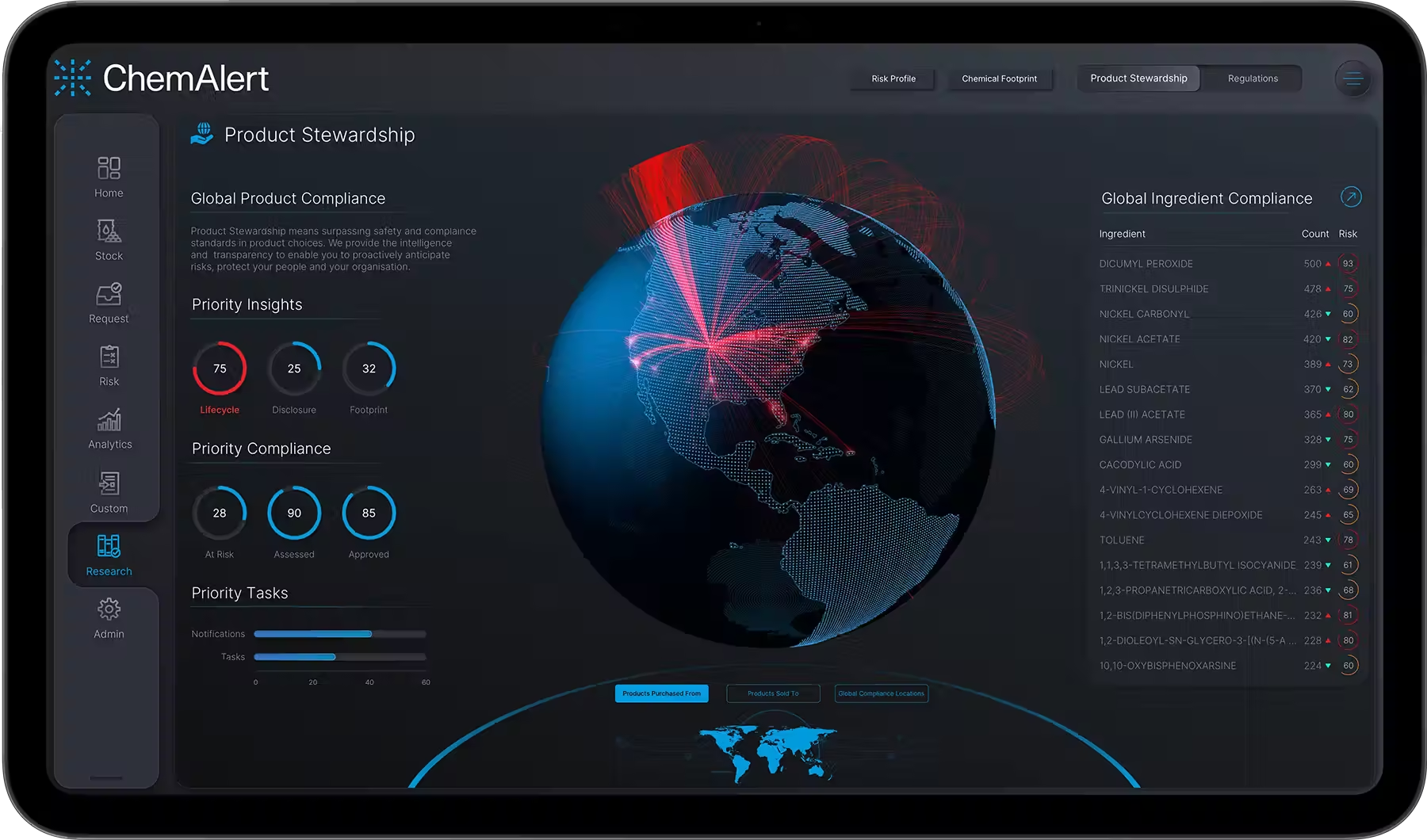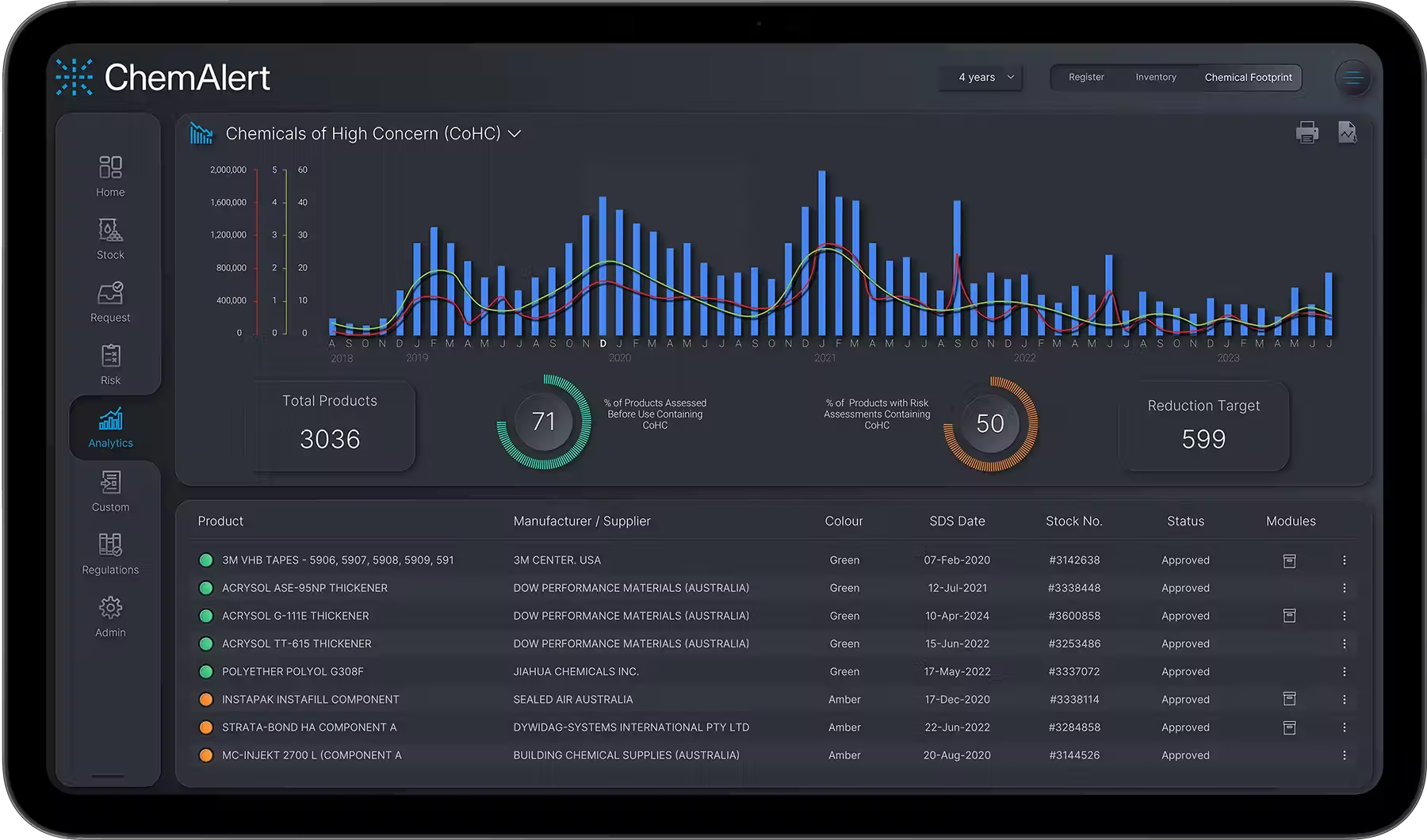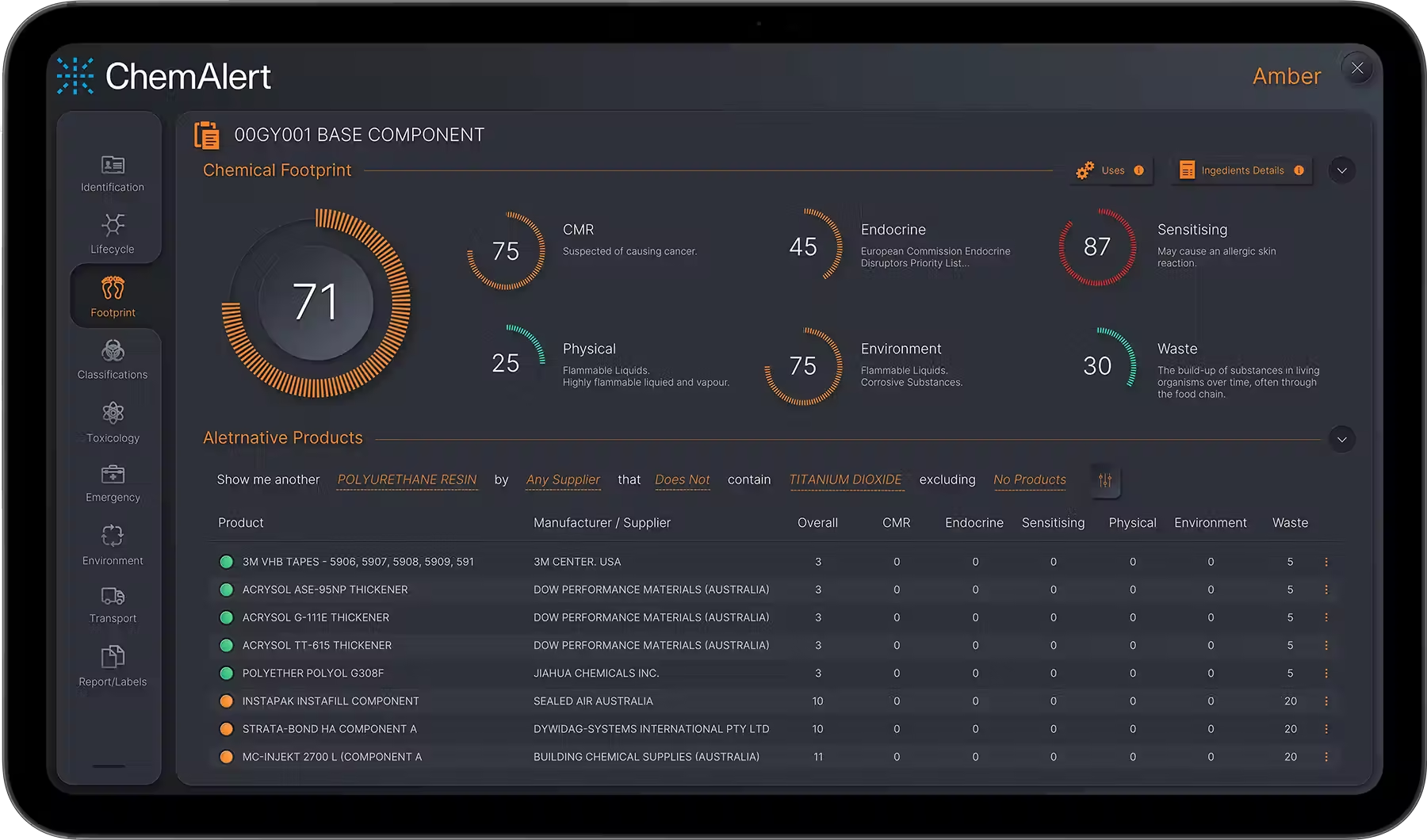Chemical Management Software for Enterprise
Know the risks. Stay protected.
Use ChemAlert.

What is ChemAlert?
ChemAlert is enterprise chemical management software that gives organisations a single SDS management system and chemical inventory management software in one platform. Teams use ChemAlert to maintain a compliant chemical inventory, access up-to-date Safety Data Sheets and reduce chemical risk across multiple sites.
Designed for scalability, ChemAlert streamlines reporting, risk assessments and procurement processes, giving businesses greater visibility and control over their chemical use. Built in Australia and trusted globally, it helps organisations reduce compliance risk, improve safety outcomes and standardise chemical management practices across the business.


Why It Matters
Five reasons why you need an enterprise chemical risk management system
How do you align chemical risks and compliance with your organisation’s values when you understand that chemical compliance alone in the past has not protected your employees, the environment, or your reputation. Many organisations have learned the hard way that legal compliance alone isn’t enough. Here’s how you can frame and align the two:

Acknowledge the gap
The first step is honesty: recognising that regulatory compliance in the past did not equate to real protection.
- Laws and standards often lag science. For decades chemicals were “compliant” yet later proven to be carcinogenic, bio accumulative, or ecosystem-disruptive.
- Compliance frameworks sometimes allow loopholes or omissions that leave workers, communities, and brands vulnerable.
- By naming this openly, you reinforce that your values are higher than mere compliance.
Define organisational values in context of chemicals
Tie risk and compliance explicitly to your stated values. For example:
- Safety first: Go beyond SDS minimums, integrate toxicological research, and adopt a “no surprises” rule.
- Sustainability: Factor lifecycle impacts, chemical footprint, and disclosure quality into procurement.
- Integrity and Transparency: Demand supplier disclosure even for unregulated ingredients; “no disclosure, no entry.”
- Reputation and Trust: Proactively eliminate Chemicals of High Concern (CoHC) before regulators catch up.
Shift from compliance-driven to science-driven
- Bayesian risk frameworks and predictive models: Show your organisation that you’re quantifying risks before incidents or regulations force action.
- Integrate emerging toxicology: Make it policy that SDS info is validated against current scientific research.
- Supplier scorecards: Rate vendors on transparency, disclosure, and sustainability—not just price.
This reframes compliance as the floor while your values set the ceiling.
Build “values-based compliance” programs
- Policy Language: State that your chemical management system is designed to “protect workers, the community, and the environment beyond regulatory requirements.”
- Metrics: Track and report not only compliance status, but also risk reductions achieved, hazards eliminated, carbon/chemical footprints reduced, and supplier disclosure scores.
- Decision-Making Tools: Ensure procurement teams see cost + compliance + sustainability + reputation as equal inputs.
Cultural alignment
- Train employees that compliance & safety; empower them to question SDS data and push for safer substitutions.
- Communicate openly with stakeholders (employees, investors, community) about how your organisation is choosing values-led chemical stewardship.
- Celebrating wins: eliminating a CoHC, preventing exposure, or achieving supplier transparency should be framed as value-aligned achievements, not just compliance milestones.


Chemical compliance must no longer be treated as protection —it’s the bare minimum
Admit where compliance has fallen short.
Translate your values into measurable chemical stewardship policies.
Go beyond regulations with science-led, disclosure-driven practices.
Build metrics and governance that reward safety, sustainability, and integrity—not just checkbox compliance.
Make chemical risk management a cultural expression of your values, not just a legal necessity.

Chemical management features
Global Source Data
As a global leader in chemical management, ChemAlert delivers unmatched access to worldwide data, helping you stay compliant wherever you operate.
Our software provides up-to-date regulatory reports and region-specific compliance information, empowering you to navigate global regulations with confidence.
Product Stewardship
Elevate product stewardship with ChemAlert’s cutting-edge chemical management software. Oversee the full lifecycle—from procurement to disposal—with unparalleled visibility.
Ensure compliance, improve safety, and drive sustainability while optimising every step for health, efficiency, and environmental responsibility.
Research
With ChemAlert, access essential safety resources backed by expert research. Our software provides manufacturer safety data sheets, independent reports, and labels created by qualified scientists.
Each document is accurate, reliable, and up-to-date, giving you confidence to manage chemicals with expert-backed assurance.
Chemical Search
Quickly find the chemical safety information you need by searching our database. With extensive filtering options, it’s easy to look for chemicals and chemical substitutes that fit your criteria.
Chemical Inventory
Simplify the way you manage your chemical inventory. ChemAlert allows you to create compliant stock registers automatically, generate reports of hazardous or dangerous chemicals, track inventory and quickly identify storage incompatibilities and banned products.
Intuitive Design
ChemAlert’s intuitive design sets us apart, making chemical management straightforward and efficient. Our easy-to-use interface simplifies complex tasks, allowing you to access and manage crucial information with ease.
Whether you’re handling safety data sheets, regulatory reports, or managing stock inventory, ChemAlert’s user-friendly platform ensures a seamless experience, helping you stay organised and focused on what matters most.

ChemAlert Benefits
Manage Compliance and Reputational Risks
Transparent reporting on products within your supply chain that contain Chemicals of High Concern (CoHC).
Footprint Management
Measure your current chemical footprint, set targets for reduction and view suggested safer alternatives.
Research Reports
Access our scientists’ up-to-date independent reviews of every SDS inside our chemical library. ChemAlert Research Reports are available to download as a summary, extended summary and full report.
Product Alerts
Get notified of any discrepancies or issues between the manufacturer SDS and the ChemAlert Research Report, directly from our scientific team.
SDS Management Software
A ChemAlert subscription license gives you instant access to a centralized library of over 400,000 of the most up-to-date original manufacturer Safety Data Sheets (SDSs).
Colour Ratings System
A fast, visual indication of the hazard level a chemical represents for normal use. We use an easily understood colour system of green (low level hazard), amber (moderate level hazard) and red (high level hazard).

Get the full picture with ChemAlert


Enterprise chemical management software
Empower your team with the chemical management software they need to make safer choices every day. ChemAlert brings together industry-leading chemical inventory management software and a global SDS management system to centralise chemical data, streamline compliance, and reduce operational risk across every site.
At RMT, we develop premium, data-driven risk management solutions designed for organisations that need accuracy, reliability and scientific rigour. With ChemAlert’s user-friendly interface, stringent information quality standards, and exceptional support, your teams transform compliance data into actionable intelligence, strengthening safety, procurement and decision-making in one integrated platform.

Discover why leading companies worldwide choose ChemAlert to manage chemicals with confidence.



Latest Posts

Simplify the way you work
Access ChemAlert, chemical management software where and when you need it with our app, available on iOS and Android devices. Our app includes features like barcode scanning ensuring you can easily keep track of your inventory on the go.
Download the app
Find ChemAlert on the App Store or Google Play.
Scan your barcode
Use your device to scan your ChemAlert barcode.
Access instantly
Watch ChemAlert sync in seconds.


How it works
Request a demonstration to see first hand how ChemAlert can work for your company.
Our team will handle the migration of any pre-existing data and guide you to customise your solution to suit your preferences.
Attend complimentary introductory training and use the direct access to our Science and Technical Support teams to help you make the most of ChemAlert.



Aviation Safety Reporting ASR in Sentinel is an example of the excellent outcomes that can be achieved by a capable, agile industry partner (RMT).
Just to let you know, I’ve been dealing with RMT for 20 years now and I’ve had nothing short of excellence with your systems and support ever since the start.
I can only say that about a handful of companies in all of this time so please keep up the good work.
When needed, the technical support is exceptional.
ChemAlert has proven to be brilliantly effective, extremely user friendly and the support backing it up is perfect.
The chemical knowledge we get thorough ChemAlert is vital should an incident occur. It means the manager and team involved can instantly utilise ChemAlert to understand what dangers are posed by the specific chemicals involved, and what precautions and actions to take.
The strong working relationship developed between Qantas and RMT has resulted in a supportive and productive culture, making compliance easy to achieve.
We've found the ChemAlert platform user-friendly, contemporary and intuitive.
Aviation Safety Reporting ASR in Sentinel is an example of the excellent outcomes that can be achieved by a capable, agile industry partner (RMT).
Just to let you know, I’ve been dealing with RMT for 20 years now and I’ve had nothing short of excellence with your systems and support ever since the start.
I can only say that about a handful of companies in all of this time so please keep up the good work.
When needed, the technical support is exceptional.
ChemAlert has proven to be brilliantly effective, extremely user friendly and the support backing it up is perfect.
The chemical knowledge we get thorough ChemAlert is vital should an incident occur. It means the manager and team involved can instantly utilise ChemAlert to understand what dangers are posed by the specific chemicals involved, and what precautions and actions to take.
The strong working relationship developed between Qantas and RMT has resulted in a supportive and productive culture, making compliance easy to achieve.
We've found the ChemAlert platform user-friendly, contemporary and intuitive.

Expert support
Your ChemAlert subscription includes unlimited scientific and technical support from our in-house scientists, software engineers, mathematicians, analysts and IT professionals. ChemAlert is backed by a dedicated scientific and regulatory research team with expertise in toxicology, chemistry, WHS compliance and global GHS standards. From chemical management to compliance, our experts are ready to answer your questions.



















FAQs
Does ChemAlert help with GHS and regional regulations?
GHS regulations
ChemAlert supports compliance with GHS regulations and regional chemical standards by providing accurate hazard classifications, validated SDS information and automated updates when regulatory criteria change. The system ensures labels, risk assessments and inventories reflect the correct GHS pictograms, signal words and hazard statements. This helps organisations minimise risk, avoid non-compliance and maintain consistent chemical safety practices across different jurisdictions.
Can ChemAlert support multi-site enterprise compliance?
Enterprise Compliance
Yes. ChemAlert is designed for enterprise compliance across multi-site operations. The platform standardises chemical data, hazard classifications and storage requirements so every site follows the same policy framework. Dashboards provide visibility into compliance gaps, SDS currency, risk levels and audit-ready records. Multi-site organisations use ChemAlert to keep processes consistent, reduce duplicated effort and maintain a unified approach to chemical safety.
What makes ChemAlert different from other chemical inventory software?
Chemical Inventory Software
ChemAlert differs from standard chemical inventory software because it combines inventory tracking with validated SDS data, scientific hazard assessments and advanced reporting tools. Its colour-coded risk indicators, comprehensive research library and high data accuracy set it apart. ChemAlert integrates with procurement and safety workflows so organisations can manage inventory, risk, compliance and decision-making in one reliable enterprise platform.
Is ChemAlert an SDS management system?
SDS management system
Yes. ChemAlert functions as a complete SDS management system. It provides fast access to manufacturer-verified Safety Data Sheets, ensures version control and maintains an updated SDS library through scientific validation. Users can search, download, print or integrate SDSs into labels, risk assessments and procedures. This gives organisations confidence that their teams have accurate and compliant chemical information at all times.
How does ChemAlert handle chemical inventory management?
Chemical Inventory Management
ChemAlert simplifies chemical inventory management by maintaining a live and accurate register of chemicals across your organisation. It tracks quantities, storage locations, expiry dates and approval requirements while linking each product to up-to-date SDS information. Automated notifications help prevent non-compliant storage practices and centralised data ensures procurement, safety and risk teams work from the same validated source of truth.
What is chemical management software?
Chemical management software
Chemical management software is a centralised system that helps organisations control, track and manage chemical information across their operations. It provides structured access to SDSs, hazard classifications, inventories and compliance documents and risk controls. Platforms like ChemAlert streamline workflows, ensure information accuracy and reduce time spent manually updating chemical registers. This improves safety outcomes, regulatory compliance and decision-making for teams that operate across multiple sites.


















































.jpg)
.jpg)
.jpg)

